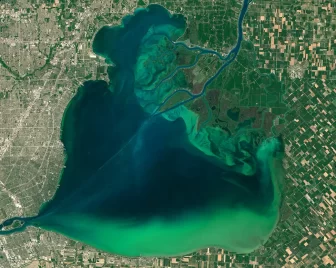
Lake St. Clair algal bloom – Algal blooms highlight the natural beauty of Lake St. Clair and its canals. Image: NASA Earth Observatory, Joshua Stevens.
By Anna Barnes
Sitting at 26 miles long and 24 miles wide with nearly one-third of the sport fishing catch annually in the Great Lakes region, Lake St. Clair should be a household name.
Author Daniel Harrison would tell you it’s his hidden jewel.
Harrison anticipates publication of his first book, Michigan’s Venice (Wayne State University Press, 2024) in April. He became a consultant maritime archeologist after retiring as a reference librarian at Henry Ford College in 2019.
With a doctorate in anthropology from Wayne State University and a desire to tell the tale of an underappreciated great lake, Harrison, 74, transformed his doctoral dissertation into a book to reach a larger audience. He spent time in his youth diving in Lake St. Clair and he’s lived near the water most of his life. He chose to do his dissertation after realizing there wasn’t much research from an anthropological perspective on the body of water.
The changing maritime cultural landscape of Lake St. Clair is responsible for some of Michigan’s top economic development, including boat manufacturing, Harrison said. Chris-Craft Boat’s original headquarters was located in Algonac, Michigan, along the St. Clair River.
“Lake St. Clair is kind of the birthplace of American recreational boating,” Harrison said. “Chris-Craft is like the Henry Ford of recreational boating. The equivalence of Ford, Chevrolet, Cadillac and so on.”
Michigan’s Venice looks at the changing maritime cultural landscape with a mix of literature, history, culture, anthropology and cartography.
An archeologist may question the use of literature while a writer may question the amount of data, but the book covers all the bases, Harrison said.
“If you’re patient and keep going, it’s like Michigan’s weather,” he said. “It will change. You will find something you like.”
A maritime cultural landscape is a place where the human use of an area has something to do with movement by water, he said. Culture is added to the phrase because the physical landscape allows for cultural association, like connecting the boats at the marina with Lake St. Clair.
Lake St. Clair is a center of cultural significance. Walpole Island First Nation is an Indigenous reserve that is the original territory called Bkejwanong, Harrison said. The land was not given to them by the government, but rather the Indigenous people never gave it up. Bkejwanong translates to “where the waters divide.”
The people who live there have maintained many of their traditional lifestyles, he said. “They have kind of restored in many ways their culture, their language and it is a cultural center.”
Unlike many groups of Native Americans, the people living on Walpole have not been displaced to the West and who are living on land that is not affiliated with their homeland, Harrison said.
Lake St. Clair and its extensions also are known for game fishing.
However, the area was almost ruined by industrial pollution. The Clean Water Act was a catalyst for game fishing to explode in the area as the waters became more habitable for several species, including walleye, sturgeon and bass.
The fishing in Lake St. Clair has seen worse times, said Jennifer Tewkesbury, the state’s coordinator for the federally-designated Area of Concern covering the Clinton River.
“Before we had water quality standards we were seeing some issues within Lake St. Clair itself with some of the fish populations declining and we were seeing some heavier metal contaminations in the fish tissue,” she said.
A changing mindset about the lake itself and new water standards contributed to its restoration, Tewkesbury said.
Lake St. Clair “is seen as a resource not just as, you know, something we can flush all of our waste and our discharges into it,” she said. “We see it more as an asset and a part of our blue economy.”
From a local perspective the lake is significant enough to be referred to as the sixth Great Lake, she said. It is home to one of the only public beaches in Macomb County.
The lake’s shallow edges and reed beds contribute to a healthy habitat for fish, Harrison said. “The fishing is phenomenal and it’s getting better all the time as we restore habitat and we clean up our water.”
Industrial pollution is not the only consequence of development in the area. Larger passages were capable of being dredged and optimized for large freighter boats after the invention of steam shovels, Harrison said. This led to rising water levels. A church, St. Felicity, and a village, Belvidere, were abandoned and eventually went beneath the water, an example of the unintended consequences to the environment that Harrison addresses.

Daniel Harrison, 74, is anticipating the publication of his book, Michigan’s Venice, set to release in April. Image: Kelsey Giffin.
Harrison uses Michigan’s Venice to explain what St. Clair has become by combining several perspectives and disciplines.
Lake St. Clair got the nickname “Michigan’s Venice,” in the late 19th century as day cruising, dining, dancing and more recreational centers popped up along the channels, he said. Consumers with more money and free time spent their leisure traveling through Lake St. Clair’s canals.
After 10 years working and re-working his doctoral dissertation into Michigan’s Venice, Harrison will see the book published in April. He will sign and sell copies and be talking about Lake St. Clair at the Historical Society of Michigan’s Local History Conference at Oakland University’s Oakland Center on March 23.
Michigan’s Venice is now available for pre-order from Wayne State University Press and local bookstores.
That’s a great photo I saved it when I first saw it, St Clair is an under cared for resource. While I certainly agree that Lake St Clair is the under appreciated Great Lake. While there are algae blooms they’re not coming from the channels of the St Clair River delta. The dry weather during the summer of 2022 left the local rivers with minimal flow. The River Thames on the southeast corner of the lake is the source of the algae bloom. One of the most impressive aspects to this photo is the water is so clear that the sand bars south of Harsens’s Island are visible. The Thames River & Lake St Clair have a similar problem to the Maumee & Western Lake Erie. St Clair is shallow not nearly as bad due to the influx of clean water from Lake Huron & the strong Detroit River current keeping the water moving. The algae problem comes from Thames River flowing through some of the most heavily farmed land in Canada. Most farmers aren’t aware that practices like using liquid manure in the spring planting season leads to excess runoff. Commercial fertilizers also kill microbes in the soil that make it hard packed & less able to soak up water. There’s been a study in the Maumee Basin around Toledo to discover why the problem is staying the same while local farmers on their own dime are switching to more organic farming practices. Even just using dried manure and less of it because let’s be honest it’s a business selling unwanted crap from concentrated animal feed lots. At least in Ohio the large amount of “concentrated animal feed lots” has been pointed to as the most recent source of algae blooms. There’s a cut off in regulation between a “mom n pop” set up and a industrial scale production. There have been a many fold increase in the number of small 10,000 head of cattle & 50,000 head of chicken operations to skirt regulations. The manure is sold as fertilizer which isn’t a bad thing just as mentioned in what form and when. Local farmer advocacy groups got together to bring attention to dying fishing towns and the lake they love. It’s called The Erie Situation & it was done by PBS Toledo. The city’s have their own share of the problems lawn fertilizers getting washed away & leaking septic tanks. City dwellers as well as farmers and rural residents all have a stake in keeping our water clean. That photo was one of the cleanest of Lake St Clair I’ve seen certainly in the era of high resolution space photography. Algae blooms while natural aren’t at the levels we’ve seen in shallow warm parts of the lakes. Green Bay, Saginaw Bay & Western Lake Erie all have problems with algae blooms all drain large amounts of farmland into warm shallow areas of water where the algae can reproduce massively. Farmers who have taken to organic methods have had to take losses for a season or two as one put it my soil detoxed from the commercial fertilizer. I’m not a farmer though I was convinced with this guy’s work on his business. I doubt there’s a one size fits all approach though but there’s not much being invested into keeping our waters clean. The loss of costal wetland certainly hurt water quality but the Lake Erie blooms of didn’t start during a massive phase of draining wetlands. As a matter of fact the Detroit International Wildlife Refuge has come into maturity at the mouth of the river and Northern Lake Erie.
Love it
From Local perspective it would be the 6th Great LakeIt’s not even close. There are literally several bays in the Lakes that Saint Claire is smaller than. Both of Traverse Bay are bigger. Saginaw Bay is many many times bigger.
Is Lake Saint Claire a good lake sure!
Correct me if I ‘m wrong here, the algae blooms are great, too. Hmmm.
Thank you Dr. Harrison , for accomplishing the research and studies in writing the “Michigan’s Venice”.
I and my husband have spent many great days and nights boating and swimming up and down that wonderful Lake St. Clair and truly enjoyed all of its offerings : hiking , barbecues, restaurants , etc.
It should be added to the Great Lake title !!!
Congratulations!!! On your Masterpiece : “Michigan Venice” !
We camped at Algonac State Park several times years ago. It’s beautiful there. Any of my friends and family will tell you I absolutely LOVE Michigan and the great lakes.
You didn’t mention the annual invasion of fish flies from the lake.
If you are a fisherman of any kind, the Musky population according to reports is around 50,000. Incredible fish to catch…then release.
A very good read… I wonder if your accretion will ever be made that Lake St. Clair should become the 6th Great Lake!!?
It’s time Lake Clair get credit for being the heart of the Great Lakes. Thank you, Sir.
You need to title it “Michigans garbage dump” non of the fish out of St. Claire are edible. I fish it, but never eat what I catch. Used to fertilize my garden until soil testing confirmed high levels of mercury were I fertilized. Sad, thank our governor for gutting michigan
I have always considered Lake St.Clair as one
of the Great Lakes….having grown up in Detroits east side near the
mouth of the Detroit River.